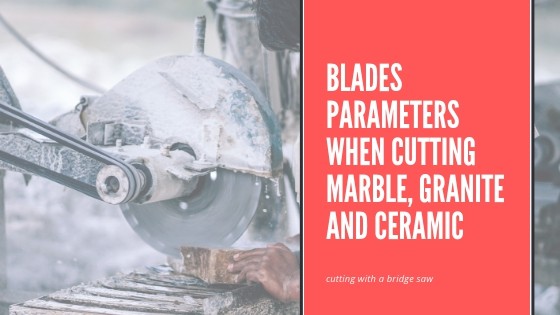When cutting natural stone or ceramic with a bridge saw, you will need to configure different parameters based on the peripheral speed of the diamond blade to achieve a precise cut and minimize tool wear.
Suggested RPMs vary based on material and blade diameter although in general, the harder the material, the slower the peripheral speed. Finding the best setting requires continuous practice and experience.
Knowing the peripheral speed to be used, what rotational speed in terms of RPM (revolutions per minute) should I use for the various diameters?
The correct disk diameter is found based on the saw’s motor speed and the material to be cut, or vice versa, for any disk diameter and material, it’s necessary to set the appropriate rotational speed in RPMs.
The tables below will allow you to find the correct range of rotational disk speed based on the material (hence the desired peripheral speed) and the disk diameter.
Of course, the parameters below are meant to be used for reference purposes and are not “set in stone”. Based on his experience and the particular bridge saw, the operator changes them if deemed expedient.
What mathematical formula can I use to obtain the correct rotational speed of the disk (in rpm) for any given diameter?
The disk RPMs can be obtained using the formula:
n = (Vp / 2*π*R) * 60.000
- n: peripheral spend in revolutions per minute (RPM)
- Vp: peripheral speed in meters per second
- π: pi (3.14)
- R: disk radius in millimeters
For example: to calculate how fast a 900mm diameter diamond blade has to rotate to cut the marble (40 m/s peripheral speed):
n = (40 / 6.28 * 450) * 60,000 = 850 RPM
Again, the peripheral speed depends on the material to cut, the harder the material, the lower the speed. The linear cutting speeds are indicated in the headers of the tables below.
Parameters for cutting marble, sandstone, and granite
| BLADE DIAMETER Ø | MARBLE [40-50 M/S] | SANDSTONE [55-65 M/S] | HARD GRANITE [25-30 M/S] | SOFT GRANITE [32-40 M/S] | |
|---|---|---|---|---|---|
| 300 mm (12”) | 2600 – 3200 Rpm | 3500 – 4200 Rpm | 1600 – 1900 Rpm | 2000 – 2600 Rpm | |
| 350 mm (14”) | 2200 – 2700 Rpm | 3000 – 3500 Rpm | 1300 – 1700 Rpm | 1750 – 2000 Rpm | |
| 400 mm (16”) | 1900 – 2400 Rpm | 2600 – 3100 Rpm | 1200 – 1500 Rpm | 1550 – 1900 Rpm | |
| 450 mm (18”) | 1700 – 2100 Rpm | 2300 – 2800 Rpm | 1100 – 1300 Rpm | 1400 – 1700 Rpm | |
| 500 mm (20”) | 1500 – 1900 Rpm | 2100 – 2500 Rpm | 1000 – 1200 Rpm | 1250 – 1500 Rpm | |
| 600 mm (24”) | 1300 – 1600 Rpm | 1700 – 2100 Rpm | 800 – 1000 Rpm | 1050 – 1300 Rpm | |
| 625 mm (26”) | 1200 – 1500 Rpm | 1650 – 2000 Rpm | 750 – 950 Rpm | 1000 – 1250 Rpm |
Parameters for cutting ceramic and porcelain
| BLADE DIAMETER Ø | DOUBLE FIRING [55-80 M/S] | SINGLE FIRING [45-55 M/S] | GRES PORCELAIN [40-50 M/S] | |
|---|---|---|---|---|
| 250 mm (10”) | 2100 – 3000 Rpm | 1700 – 2100 Rpm | 1500 – 1900 Rpm | |
| 300 mm (12”) | 1750 – 2500 Rpm | 1400 – 1750 Rpm | 1280 – 1600 Rpm | |
| 350 mm (14”) | 1500 – 2200 Rpm | 1250 – 1500 Rpm | 1100 – 1400 Rpm | |
| 400 mm (16”) | 1300 – 1900 Rpm | 1100 – 1300 Rpm | 960 – 1200 Rpm | |
| 500 mm (20”) | 1050 – 1550 Rpm | 860 – 1050 Rpm | 780 – 960 Rpm |
If you require a recommended rpm for a different size or material not indicated above, please write to us at
To purchase diamond bridge saw blades:
Conclusion
You can use the tables above for consultation on the rotational speed needed (in rpm) to cut a specific material.
The table only shows the most common disk diameters and materials used, but the formula can calculate the rotational speed for diamond disked to be mounted on an angle cutting tool or on a block cutter, and if you know the peripheral speed need to cut other materials, you can easily calculate the rpm for materials other than those shown above as well.
With the correct parameters and experience, you will be able to cut precisely and efficiently.
If you have any questions or doubts, please leave a comment below.

 Diamond Blades
Diamond Blades Angle Grinder Tools
Angle Grinder Tools Polishing Machine Tools for Stone, Marble and Granite
Polishing Machine Tools for Stone, Marble and Granite Texture tooling
Texture tooling Adhesives and glue
Adhesives and glue Ceramic, Granite and Marble Drill Bits
Ceramic, Granite and Marble Drill Bits Sculpture – Stone carving tools
Sculpture – Stone carving tools Diamond Wires for Granite and Marble Quarries
Diamond Wires for Granite and Marble Quarries Cemetery and Graveyard Accessories
Cemetery and Graveyard Accessories CNC Vacuum Pods
CNC Vacuum Pods CNC Tool Holders
CNC Tool Holders CNC Tool Forks
CNC Tool Forks Positioning Alignment Lasers
Positioning Alignment Lasers Material Handling
Material Handling Machinery
Machinery Spare parts
Spare parts Electrical Spare Parts
Electrical Spare Parts Personal Protective Equipment
Personal Protective Equipment

Dear sir
what is RPM for block cutter dia. 1000cm to cut granite?